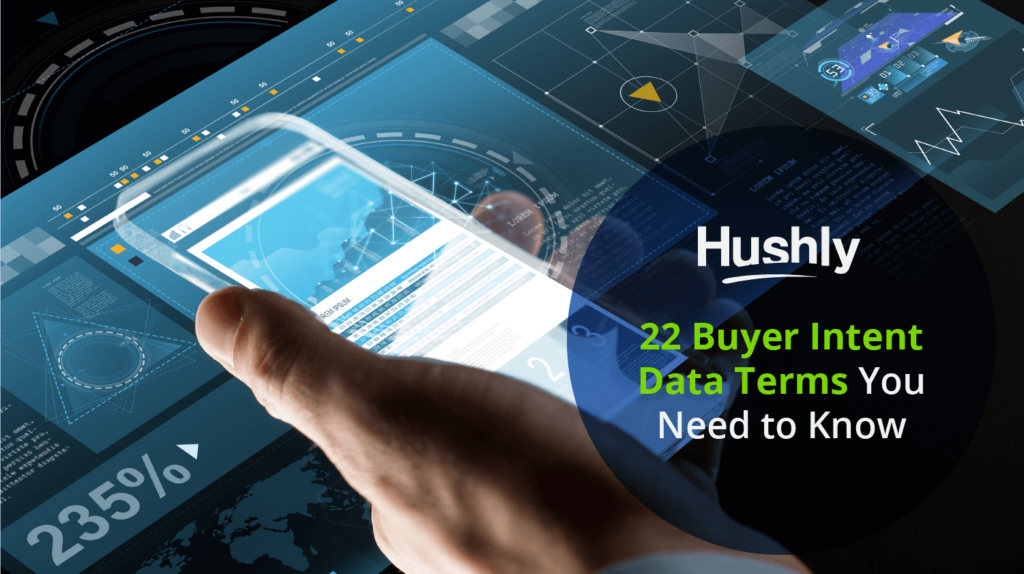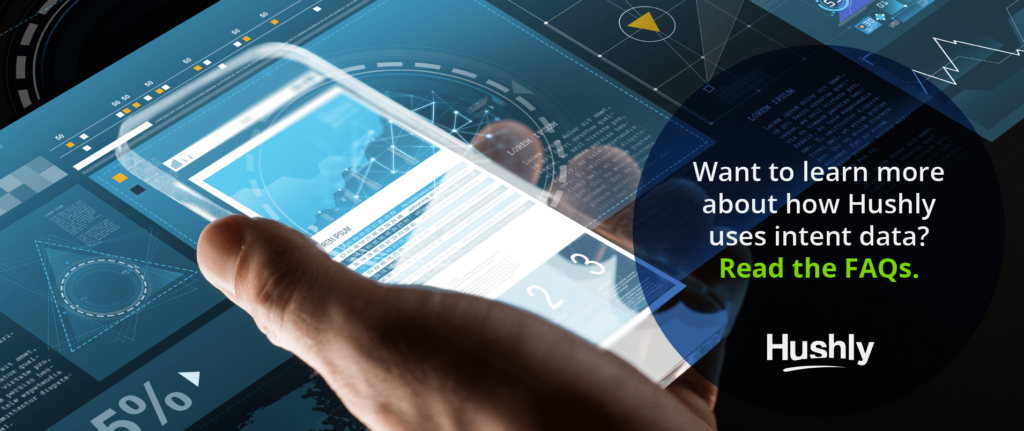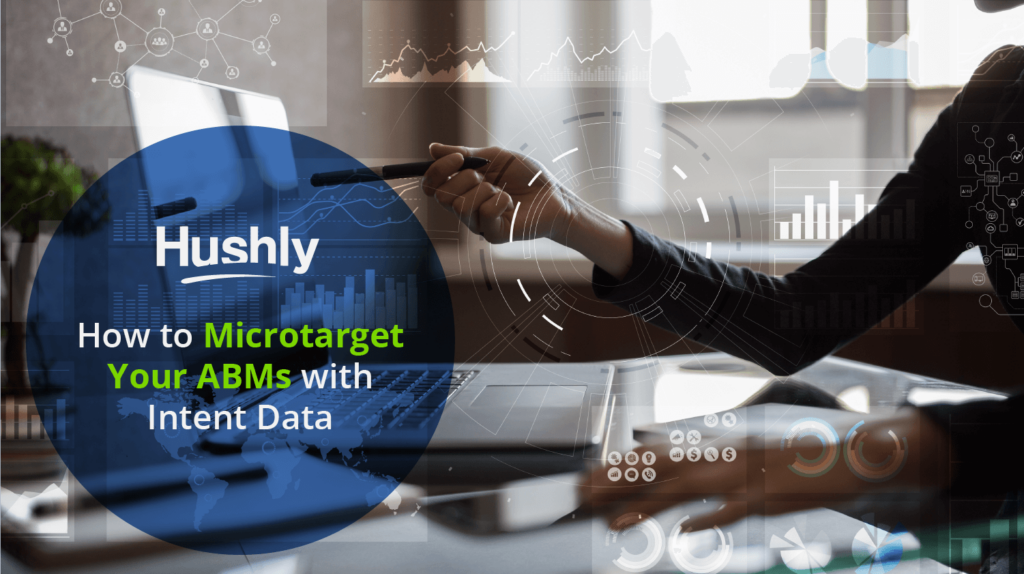Filters
Content Type
Topic
22 Buyer Intent Data Terms You Need to Know

You can expect intent data to be a major topic of discussion in 2021.
Apple has already blocked third-party cookies as of March. Meanwhile, Chrome plans to phase them out by 2022.
For many B2B marketers, that calls their entire personalization strategy into question.
Specific types of buyer intent data will undoubtedly feel the squeeze. However, intent data seems posed to withstand the death of cookies due to the ways data is collected.
Still, intent data is uncharted territory for many marketers with plenty of unfamiliar terms. Here’s what you need to know before jumping in.

Your Buyer Intent Data Glossary: 22 Terms You Need to Know
Even marketing experts might not be aware of all the terms associated with buyer intent data. Did we miss anything? Let us know!
1. Activation Point
The plan you’re incorporating intent data into your marketing tactics. Hushly, for example, includes instant access to intent data when you launch the platform. However, other intent data providers hand you the raw data and let you figure out how to use it.
2. Audience Status
Within monitoring tools, audience status functions as a lead scoring feature. Active status means a lead is receiving sales promotions and nurturing content. Meanwhile, marketing a lead inactive pauses your targeting strategies to avoid wasting resources.
3. Bidstream Data
Intent data from a bitstream comes from paid ad exchanges and keywords. Bidstream data works without third-party cookies and includes no personally identifiable information but offers less in the way of analytics.
4. Buyer Intent Data
Data aggregated from multiple apps, websites, and publications to understand a visitor’s intent, stage of the buying cycle, and if they’re researching your company.
5. Co-opt Data
Aggregate data from a wide range of sources like publishers, blogs, webinars, vendors, and agencies. Although it provides less in volume than bidstream data, it makes up for it with better quality.
6. FIRE
B2B marketers have started using the FIRE acronym to organize their buyer intent data.
- Fit: Does the lead fit your current buyer persona? How do their firmographics compare to your current customers?
- Intent: How likely is the account or lead to purchase from you? Where are they at in the buyer’s journey, and do their needs fit your solutions?
- Recency: When did a lead take action that shows intent? Yesterday or two years ago?
- Engagement: Which accounts are currently engaging with your company? How and when?
7. First-Party Buyer Intent Data
Intent data you’ve collected through your own website – based on behavioral data from tools like Hushly. First-party intent data can be known or anonymous.
8. Inferred Contacts
Contacts who are assumed to have triggered an intent signal because they were in the right place at the right time. You can’t be sure, however, so call them inferred.
9. Intent Contacts
You know these contacts took action that displays intent. Maybe they signed up for your email list or downloaded a whitepaper.
10. Intent Keywords
A type of keyword research – usually from bitstreams – that tells you the intent of an account or lead. You can tell a lot about a lead’s stage of the buyer’s journey by analyzing keywords. The longer and more actionable, the closer they are to a conversion.
11. Intent Signals
An event that tells you a particular visitor or lead is seriously considering your company. They might download an eBook, read a handful of case studies, or RSVP to an event.
12. Intent Topics
Intent topics help you add more context to your intent keyword research. For example, someone who visits a niche case study on your website is much closer to purchase than someone browsing your blog post. However, both content assets might emulate the same intent keywords.
13. Intent-Qualified Account
An account (in ABM) who seems ready for follow-up nurturing via email or messages based on their intent signals and browsing behavior.
14. Intent-Qualified Lead
An individual lead deemed fit for follow-up nurturing based on their behavioral activity.
15. Intent Monitoring
You’ve heard of social monitoring, right? You track a particular keyword, phrase, or brand on social media to follow their behavior.
Intent monitoring tools like you do the same thing with leads and accounts. Intent monitoring uses natural language, topics, keywords, and signals to identify hot leads and prevent customers from churning.
16. Natural Language Processing
A type of programming or artificial intelligence focusing on imitating natural human language for the purpose of improving customer experience.
17. Spike Alerts
Some intent monitoring tools let you set a threshold for signals – much like you would on investment apps to buy/sell when the share reaches a certain price.
Spike alerts tell you if an account suddenly becomes active after a period of dormancy or increases their engagement on your website.
18. Standalone Publisher Data
Many publishers own an entire collection of digital media assets. Standalone publisher data comes from their portfolio data. It’s high-quality but doesn’t offer the same breadth of other options.
19. Third-Party Buyer Intent Data
Intent data you’ve purchased or received from a third-party source. Hushly partners with 6Sense to offer third-party intent data.
20. Topic Clusters
You can categorize content assets into topic clusters to build a better understanding of intent and interest. For example, you might have a cluster of case studies for a specific vertical or company.
21. Topic Taxonomy
A special categorization of topics to understand intent. It’s not as simple as picking your case studies and whitepapers. An AI-driven algorithm studies the content and visitor behavior to carefully test and group your topics with natural language processing.
22. Use Cases
The many applications of intent data such as:
- Targeted account-based marketing
- Improving lead quality
- Increasing lead conversions
- Targeted PPC ads
- Account and lead scoring
- Preventing customer churn
- Creating content
- Event planning
Harness the Power of Buyer Intent Data and AI to Skyrocket Lead Quality
Hushly’s AI engine lets you harness the power of buyer intent data and behavioral data you’re already collecting through your website. Using algorithms like Netflix or Amazon, you can create a hyper-personalized experience with minimal effort. The result? An increase in lead conversions by 51% and lead quality by 59%!
Want to learn more about how Hushly uses intent data? Read the FAQs.

The post 22 Buyer Intent Data Terms You Need to Know appeared first on Hushly.


